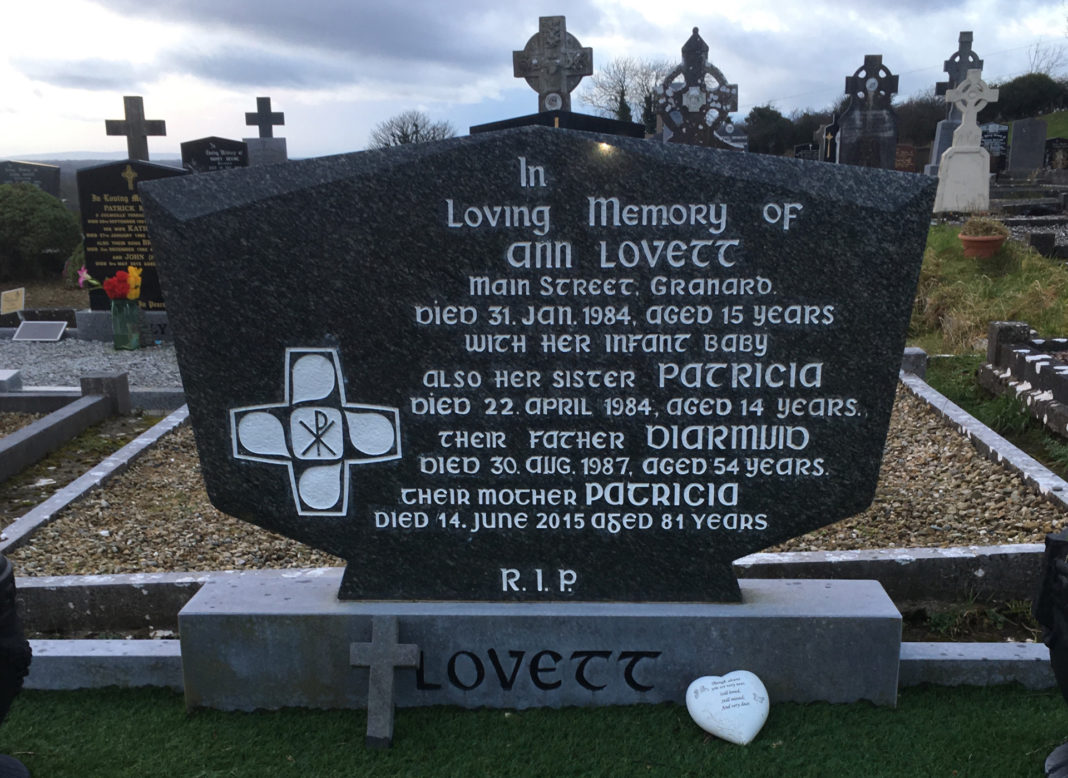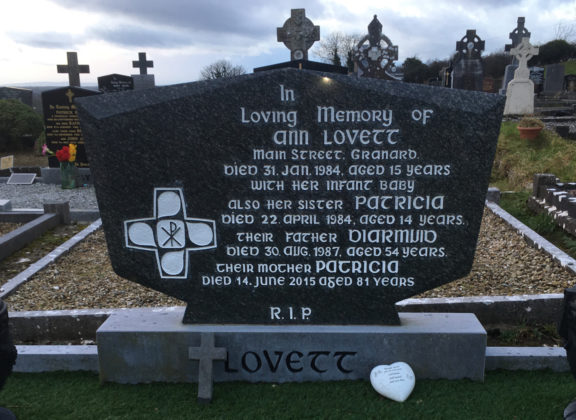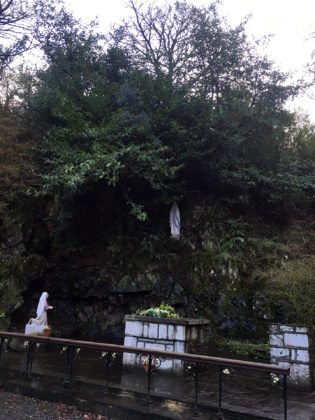34 years ago today, Ann Lovett died after giving birth at a grotto in Granard. Ann’s death changed an Ireland which is still trying to escape the long shadow of the 1980s, writes Donal O’Keeffe.
Granard, Co Longford, is a very picturesque town. It dates back at least to Celtic times and is mentioned in the Táin Bó Cuailgne. Queen Medb and her army stopped in Granard, on their way to take the brown bull of Cooley. So ancient a place is Granard that the original meaning of its name is unclear in Irish. It’s said St Patrick appointed the son of his former master the first bishop of Granard.
Granard is dominated – literally – by the Catholic Church. As you enter from the Edgeworthstown side, you’re immediately aware of the hill looming up on your left, and the grey St Mary’s Church which overlooks the entire main street. At the top of the hill, above the church, is a statue of St Patrick. Below that statue, behind the church, is a Marian shrine. The concreted ground is slick with moss, as a stone Saint Bernadette gazes up with unliving eyes at the statue immortalised by Paula Meehan in her poem ‘The Statue of the Virgin at Granard Speaks‘.
It was here, on the bitterly-cold, wet afternoon of Tuesday, 31 January, 1984, that Ann Lovett, a warm, clever and artistically-gifted 15-year-old girl, left Cnoc Mhuire (The Hill of Mary) Secondary School. She walked the length of Granard, past her Main Street home, to the grotto of the Blessed Virgin to give birth to her son. He died at birth.
Around 4pm, schoolchildren found her schoolbag and heard her crying by the grotto. Ann was haemorrhaging heavily and suffering from exposure. They raised the alarm and a local farmer came to their aid. He ran to the nearby house of the parish priest, who said “It’s a doctor you need”.
“I need you too, Father,” he replied. “The baby is dead and the little girl might be dying too.”
Ann was carried to the priest’s house. A doctor was called and he drove Ann to her home. There, an ambulance arrived, far too late. Ann died in Mullingar Hospital a short time later.
Three days after, on the Friday, Ann Lovett and her baby were buried.
Emily O’Reilly, tipped-off by an anonymous call from Granard, broke the story in the Sunday Tribune, and Gay Byrne, back when the Late Late Show aired on Saturday nights, previewed its headline.
“’Girl, 15, Dies Giving Birth In A Field.’ My goodness me,” said Gaybo, letting the paper fall to the floor. “Nothing terribly exciting there.”
Not a fortnight later, Byrne would change his tune as his radio show was inundated with letters from women telling similar stories. Gay Byrne and his team read out letter after letter, with Byrne saying later, “Too many letters. They couldn’t be ignored.” The Ann Lovett letters became a watershed.
We didn’t talk about sex, back then, or sexuality. It’s hard to imagine those times now, but we lived in Ionaland then, where “illegitimacy” would remain a legal concept until 1987 and where the worst fate that could befall a girl or woman was to “fall pregnant” outside of marriage.
This was only four months after the Eighth Amendment, when 841,233 voters enshrined in our Constitution the notion that the unborn – regardless of their development between conception and birth – have an equal right to life as the fully-sentient person carrying them, whether she wants to or not, whether her pregnancy is viable or not and whether she had a choice to become pregnant or not. This was a time when otherwise-normal citizens roared “MURDERER” at those campaigning against the amendment.
Ireland was a strange, fevered place before the sheer scale of sex abuse revelations broke the Catholic Church’s stranglehold. It was an Ireland of Kerry Babies and moving statues, an Ireland where Mother and Baby Homes and Magdalene Laundries and Industrial Schools were still in operation, an Ireland where contraception was prescription-only, where divorce was impossible, where homosexual acts were illegal.
It seems likely it was the difficult decision taken by Vincent Browne, then Sunday Tribune editor, to name Ann – despite concerns about intruding on her family’s grief – that personalised her, that made her more than just an anonymous story. The father of Ann’s baby was never publicly identified. Speculation ran rife, of course. It was suggested Ann had a very difficult life at home. Some speculated darkly beyond that.
Tragedy upon tragedy, Ann’s younger sister Patricia died of an overdose not three months after Ann.
The local community closed ranks, angered by suggestions people must have known Ann was pregnant. The consensus said Granard was treated unfairly by the media. “Whoever gave the news to Dublin,” thundered the parish priest, “was only spreading scandal.”
Nuala Fennell, Minister for Women’s Affairs, caused huge upset when she likened Granard to “The Valley of the Squinting Windows”. The Longford Leader asked who could say that “Ann Lovett did not die happy? Who is to say that she and her son are not in heaven? Who is to say that she had not fulfilled her role in life as her God had decreed?”
At the time, one of Ann’s friends spoke anonymously to RTÉ’s Today Tonight: “I think a lot of people knew. Like I knew months ago… It was known she was pregnant. It was known, and I don’t see why they should hide the fact. It could happen to any of us. I feel bitter to everyone, including myself… We were all friends and yet she didn’t have the confidence to come to us.”
We have no idea what Ann wanted for her future, or for her baby’s future, or if she thought that far ahead at all. We have no photograph of Ann, not one. She would be nearly 50 now.
Looking back at The Ann Lovett Letters in 2004, Gay Byrne noted that he had also received “a whole host of letters saying ‘You’re making all this up, you know. This never happened. This is total nonsense. And it’s the D4 Media again, concocting stories and there is no basis in truth for anything like that, because this is Ireland and things like that don’t happen in Holy Catholic Ireland.’
“When you read the letters now,” said Byrne, “it seems to me that not only are we living in a different country, not only are we living in a different era, but it seems to me we are living on another planet. Because those letters are a perfect depiction of the sort of Ireland we lived in at that time.”
Today, 34 years after Ann Lovett’s death, Ireland is still not free of the 1980s. Earlier this month, the Gardai and the Taoiseach apologised to Joanne Hayes for the absolute crucifixion visited upon her at the Kerry Babies Tribunal. Later this year, we will finally have a chance to repeal the Eighth Amendment. A Sunday Business Post Red C poll last week showed 60% currently favours repeal.
Beneath the stone virgin at Granard, there is no plaque, no memorial, no sign at all to mark Ann Lovett’s death. A mile away, at Granardkill cemetery, Ann’s gravestone reads:
“In Loving Memory of
ANN LOVETT
Main Street, Granard
Died 31 Jan 1984, aged 15 years
With her infant baby
Also her sister PATRICIA
Died 22 April 1984, aged 14 years
Their father DIARMUID
Died 30 Aug 1987, aged 54 years
Their mother PATRICIA
Died 14 June 2015, aged 81 years
R.I.P.”











